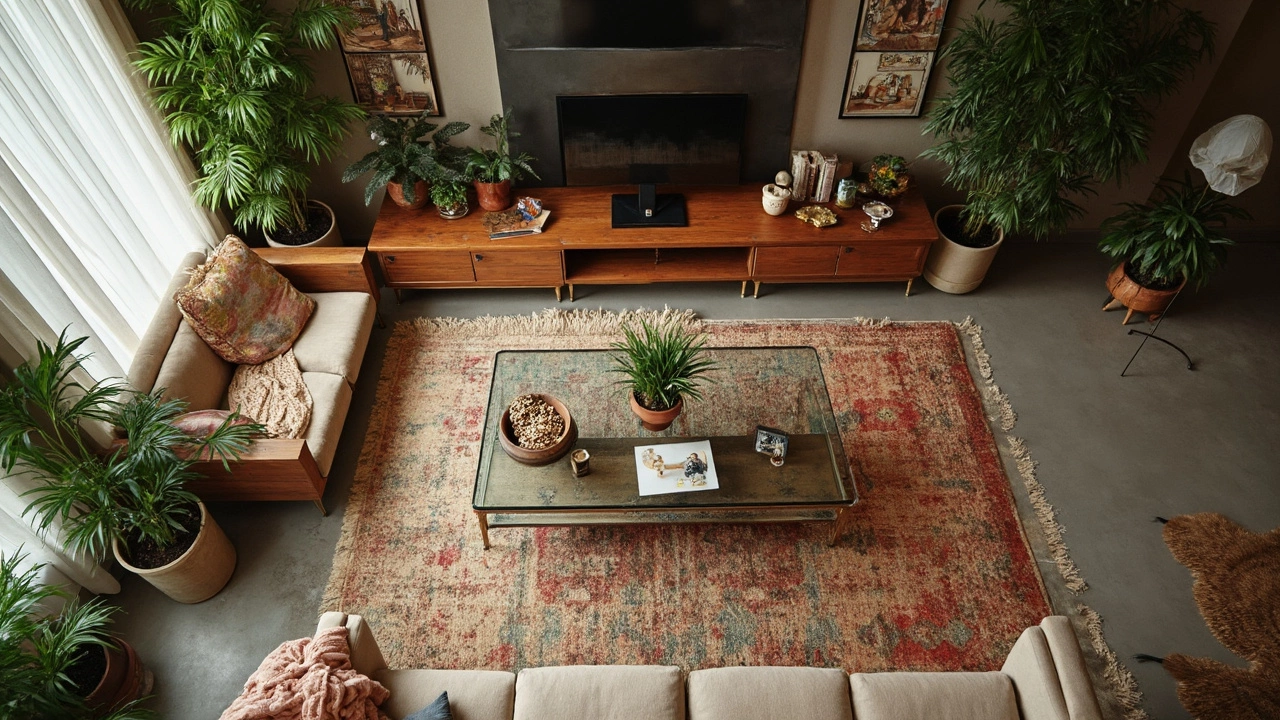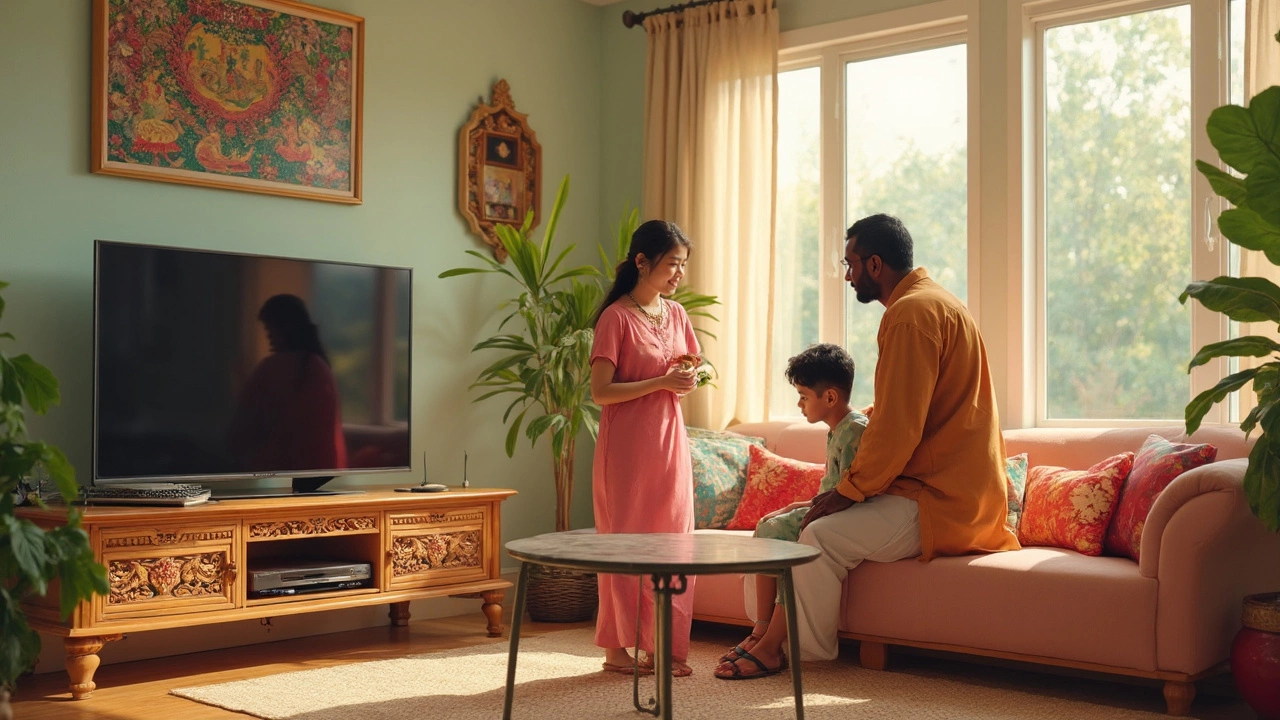If you're staring at your living room and wondering if your TV stand really needs to match your coffee table, you’re not alone. This is one of those questions that comes up every time someone moves or redecorates. You might think matching is the golden rule, but actually, today’s design world says there’s more freedom than ever. The truth is, a perfectly coordinated set isn’t always the answer—sometimes it even makes a room look stiff or boring.
Instead of worrying about making everything match, it helps to look at your space as a whole. What’s your vibe—laid-back or super modern? Do you like a pop of color, or are you more into earthy tones? The main thing is this: your TV stand and coffee table should work together, but they don’t have to be twins. They just need to look like they belong in the same story.
Let’s get into what really matters when picking these two pieces. You’ll need to think about balance, color, and function. And while some people love that sleek, matching set straight from the catalog, others are pulling off bold looks by mixing wood with metal, or glass with painted finishes. If you want your place to look put together without feeling boring, there are ways to blend different styles so everything feels just right without being too predictable.
- The Matching Dilemma: Old Advice vs. Modern Trends
- Pros of Matching Furniture: Why It Works
- The Case for Mixing Styles: Breaking the Rules
- How to Balance Different Pieces: Practical Tips
- Common Mistakes and How to Avoid Them
- Personal Touches: Making Your Space Your Own
The Matching Dilemma: Old Advice vs. Modern Trends
It’s wild how much pressure there used to be to match your TV stand and coffee table. Not long ago, every furniture store was pushing those three-piece living room sets—same finish, same hardware, same everything. People thought if your furniture didn’t look like it came as a package deal, you were doing it wrong. In the early 2000s, matching furniture was a sign you’d ‘done it right’ and had your life together.
But things have shifted. Home decor magazines and social media feeds started bursting with different looks, and suddenly, the matchy-matchy approach seemed kind of old-fashioned. Now, designers and regular folks both lean into mixing things up. For example, a 2022 Houzz survey found only about 28% of homeowners said “perfectly matched” sets were important for their living rooms. Most people now look for furniture that’s ‘coordinated’ but not identical.
This change is partly because open-plan living has taken over. Your living, dining, and even kitchen areas all bleed together, so designers mix different pieces to keep things interesting and personal. There’s less pressure to buy everything in the same color or wood finish—mixing it up actually makes spaces feel more relaxed.
| Year | Percentage Preferring Matched Sets |
|---|---|
| 2005 | 57% |
| 2015 | 39% |
| 2022 | 28% |
Bottom line: matching your TV stand and coffee table is an option, not a rule. Modern trends lean way more toward mixing styles, colors, and materials. If you get the proportions and the overall vibe right, your furniture doesn’t need to look like it’s from the same family. What matters is that your living room feels comfortable, looks balanced, and suits your lifestyle.
Pros of Matching Furniture: Why It Works
Going with a matching TV stand and coffee table is the safest route for anyone who wants their living room to feel super coordinated without much effort. When these two big pieces have the same finish or design, your space comes together fast—it just looks organized. This approach saves time, especially if you’re not into experimenting or love a classic, showroom feel. It’s popular in stores for a reason: people find it easy and reassuring.
Matched furniture also makes your space feel more spacious and calm. Repetition of similar shapes and colors tricks your brain into seeing the room as bigger and less chaotic. Rooms with coordinated sets often photograph better, which is why you see so many matching pieces in home catalogs. For small apartments or open-plan spaces, this can be a smart move.
Here’s what you can count on when going with a matching look:
- Visual harmony: Nothing clashes, so the room looks put together any time of day.
- Less decision-making: No worrying about what matches what when you shop or decorate.
- Higher resale value: Coordinated pieces sometimes appeal more to buyers when staging a home.
- Easy updates: If you want to swap pillows, throws, or art, the neutral set lets you change accents without fuss.
If you're curious about how common this setup is, check out this quick snapshot—taken from a 2024 survey by an interiors retailer:
| Living Room Setup | % of Respondents |
|---|---|
| Matching TV Stand & Coffee Table | 42% |
| Contrasting (Different Styles) | 35% |
| Mix of Old & New | 23% |
So, while mixing is trending, almost half of people still go for matching pieces. The secret benefit? You’ll never second-guess if your furniture clashes. It just works—right out of the box.
The Case for Mixing Styles: Breaking the Rules
If you look around at a lot of home tours or Instagram rooms, you’ll notice something right away: nobody’s sticking to one look anymore. Matching furniture sets are getting replaced by combos that mix wood, metal, glass, and color. Designers now say it’s all about personality rather than playing by old-school rules. According to Apartment Therapy’s annual survey in 2024, nearly 70% of respondents said they prefer a “collected look” over perfectly matching pieces.
“Rooms get boring fast when everything matches exactly—mixing styles and finishes adds instant energy,” says Emily Henderson, home stylist and bestselling author.
Mixing styles isn’t a random free-for-all, though. When it’s done right, it can make your living room feel relaxed but still totally intentional. Want an example? Pair a rustic, chunky wood coffee table with a clean-lined, painted TV stand—there’s contrast, but also a balance if you repeat the color or echo a shape somewhere else in the room.
If you’re new to mixing, these tips will help:
- Stick to a simple color palette: It lets different materials play together without clashing.
- Repeat shapes or patterns: A round coffee table with a TV stand with soft edges helps everything feel cohesive.
- Consider texture: Mix smooth surfaces (like glass) with rough ones (like reclaimed wood) for more depth.
Here’s how living room decor trends in mixing and matching titles stack up in 2025:
| Mix & Match Trend | Popularity (2025) |
|---|---|
| Wood & Metal Combos | 42% |
| Contrasting Colors | 27% |
| Matched Sets | 21% |
| Glass with Wood/Metal | 10% |
Notice how matched sets are starting to trail behind! So, if you’re thinking of pairing that industrial TV stand with a mid-century coffee table, go for it. The key is to make sure at least one element ties the space together, like a similar stain or finish, or even just sticking to the same type of hardware. Breaking the rules can lead to a room that’s not only stylish, but feels more like you.

How to Balance Different Pieces: Practical Tips
Getting your TV stand and coffee table to work together is more about vibe than rules. Here’s what actually works if you don’t want your living room to look like a random furniture warehouse.
- Stick with a color family. Even if the pieces aren’t pure copies, pick colors that feel like cousins, not strangers. Grey wood coffee table with a black TV stand? Totally fine if you bring in a couple throw pillows or a rug that tie those shades together.
- Match at least one element. Maybe it’s the legs—a metal frame on both, or a similar style of knobs. Even a shared finish (like matte vs. glossy) can give a room that “planned it” look.
- Play with textures, not chaos. Mixing a glass coffee table with a wooden stand works if there’s a common thread. Maybe both pieces have clean lines, or they share a modern shape. Don’t just go wild with textures—make sure at least one thing matches or complements.
- Pay attention to scale and height. Your coffee table shouldn’t totally dwarf your TV stand or vice versa. Usually, a TV stand is about 18-24 inches high, and a coffee table should hover close to sofa-cushion height. If one’s much chunkier or taller than the other, the space can feel awkward.
- Balance what you put on them. If your TV stand is busy with shelves and gadgets, keep the coffee table simple and clean. Got a statement coffee table? Go for a basic, low-profile TV stand so things don’t fight for attention.
If you’re not sure, snap a photo of your room from across the space. It’s wild how many clashing details jump out on a screen. Swapping a tray, plant, or stack of books between the two pieces can bring surprising balance, and it’s way cheaper than buying new furniture.
Common Mistakes and How to Avoid Them
It’s really easy to end up with a living room that feels off, even if you’ve spent a lot of money on furniture. Here’s where things usually get messy when figuring out if a TV stand and coffee table should match, and how to steer clear of these pitfalls.
- Going Full-On Matchy-Matchy: Buying sets because it’s easy. This can make your room look like a furniture store instead of a home. Your space needs variety—think about mixing different materials or shapes to keep things interesting.
- No Balance in Scale: A giant TV stand with a tiny coffee table (or vice versa) throws everything out of whack. Most designers suggest keeping the table about two-thirds the length of the sofa and at a similar height to the seat, and the TV stand shouldn’t overpower the table or vice versa.
- Ignoring Function: Sometimes, the mistake is picking style over function. If you binge-watch shows or host friends often, both pieces need to be sturdy and practical. Sharp metal corners and glass tops may look cool, but they’re not great for homes with kids or pets.
- Trouble With Color and Finish: Mixing too many different finishes, like three shades of wood and clashing metal, creates a messy vibe. Limit yourself to two main finishes across both pieces for some cohesion.
- Forgetting the Rest of the Room: It’s not just about these two items—they need to work with the rug, couch, and even the shape of the room. When there’s no common thread, everything feels random.
Here’s a quick reality check on living room setups in the US, according to a 2023 survey by HomeAdvisor:
| Living Room Style | % of Homes With Matching Furniture Sets | % With Mixed Furniture Pieces |
|---|---|---|
| Traditional | 62% | 38% |
| Modern | 34% | 66% |
| Boho/Eclectic | 15% | 85% |
See that? Matching isn’t as popular as it might seem—especially in modern and eclectic homes.
If you want to avoid common decorating fails with your TV stand and coffee table, keep these quick tips in mind:
- Pair similar shapes or materials, but mix up textures for depth.
- Watch your scale—both pieces should make sense next to the sofa and with each other.
- Stick to a simple color palette so the room feels coordinated, not crowded.
- Before buying, take photos of your living room (and current furniture) so you can compare instantly at the store or online.
Getting it right isn’t about sticking to strict rules—it’s about balance and thinking about how it all feels when you walk into the room.
Personal Touches: Making Your Space Your Own
This is where your living room really gets to show your personality. Nobody wants their place to look like a furniture showroom, right? It’s the stuff you add—your favorite mug on the coffee table, a cool bowl from your last trip, a quirky lamp on the TV stand—that makes your space feel lived-in and real.
If you’re hesitating about mixing and matching, remember there’s no right or wrong as long as it honestly feels like you. Interior designers often say that a personal item, like photos or souvenirs, anchors your style better than anything mass-produced. Even big brands like IKEA and West Elm suggest using trays, books, candles, and baskets to tie together pieces that aren’t exactly alike. It’s proven: layering textures and adding personal items creates spaces people want to hang out in.
- Pick a few colors you love, and bring those shades into both your TV stand set-up and your coffee table arrangement. This could be as simple as matching a picture frame on one with a plant pot on the other.
- Go for a mix of textures—maybe a rough woven basket next to a glossy coffee table, or a stack of old books on a smooth wooden TV stand.
- Try grouping items in threes—a rule decorators use to keep things looking balanced but casual.
- If you find a piece you love that doesn’t match, grab it anyway. You can always connect it to your space with a pillow, rug, or artwork that shares a color or vibe.
Last thing: don’t rush to fill every inch. Leaving some empty space lets your favorite things get the spotlight. When your room includes stuff that matters to you, nobody’s going to care if your TV stand matches your coffee table. They’ll just think your place feels like home.

